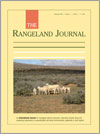RJ13033Establishing the carrying capacity of the grasslands of China: a review
Rehabilitation of degraded grasslands and improving farmer incomes are important issues for China’s grasslands. In this review grassland conditions in China and the relationship between forage production and animal performance for three important national grassland regions are described. From the review of the literature, the aim is to establish better practices for the sustainable management of grassland resources in China.




